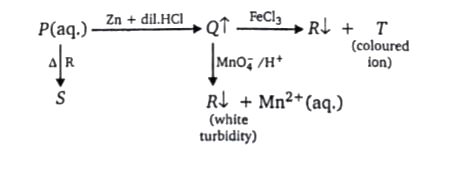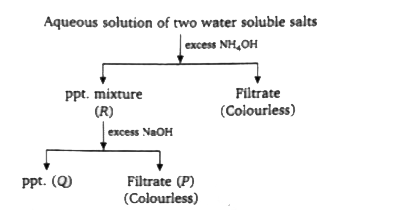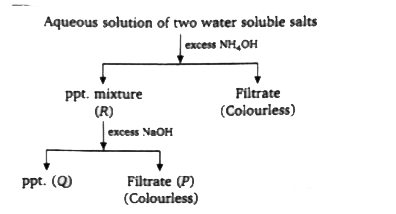LEVEL 3 from VK JAISWAL ENGLISH TYPES OF REACTIONS for Class 12
| Class 12 | CHEMISTRY |
| Chapter | TYPES OF REACTIONS |
| VK JAISWAL ENGLISH | LEVEL 3 |
| Medium | English |
| Academic Year | 2023-2024 |
Question 3
Consider three P, Q, R, salts among them P and Q salts have different cations annd also have different coloured polyatomic anion due to charge transfer phenomenon while P and R salts have same cation but have different anions. Salts R decomposes into an acidic gas an a basic gas.
Q. Salt R can not be:View SolutionQuestion 4
Consider three P, Q, R, salts among them P and Q salts have different cations annd also have different coloured polyatomic anion due to charge transfer phenomenon while P and R salts have same cation but have different anions. Salts R decomposes into an acidic gas an a basic gas.
Q. Salt P decomposes on heating into a coloured solid, neutral gas a neutral vapour, then which of the following can not be the product of salt P after decomposition?View SolutionQuestion 5
Consider three P, Q, R, salts among them P and Q salts have different cations annd also have different coloured polyatomic anion due to charge transfer phenomenon while P and R salts have same cation but have different anions. Salts R decomposes into an acidic gas an a basic gas.
Q. If salt Q underrgoes redox reaction with H2S in acidic medium then which of the following speies can not be possible product?View SolutionQuestion 6
Three compound X, Y and Z were taken into three different laboratory vessels annd they are carried out by a chemist in his car. The car caught fire due to short circuit and the chemist came out of the car and noticed following observations:
Q. Compound X changes into white substnace along with liberation of neutral oxide and then white substnace decomposed into three products among which two are acidic oxides. among these oxides non-polar oxide can undergo polar cyclic polymer on cooling. the compound X will be:View SolutionQuestion 7
Three compound X, Y and Z were taken into three different laboratory vessels annd they are carried out by a chemist in his car. The car caught fire due to short circuit and the chemist came out of the car and noticed following observations:
Q. Compound Y produced two oxides, among these oe oxide turns anhydrous CuSO4 into blue and other gas slows down fire in the car, then Y isView SolutionQuestion 8
Three compound X, Y and Z were taken into three different laboratory vessels annd they are carried out by a chemist in his car. The car caught fire due to short circuit and the chemist came out of the car and noticed following observations:
Q. Which of the following compound does not react with cold and dil. HNO3?View SolutionQuestion 10
In salts of polyatomic anion, as polarising power of cation increase, thermal stability of the salt decrease and decomposed species may further undergo redox reaction
Q. Water soluble salt(x) was heated into three products A, B and C and B and C are two different paramagnetic gases. A is red in hot condition, then salt(x) is :View SolutionQuestion 11
Dioxygen directly reacts with nearly all metals annd non-metals except some metals (e.g., Au, Pt) and some noble gases and form oxide(s). Oxides can be simple (e.g., MgO, Al2O3) or mixed (Pb3O4,Fe3O4). Simple oxides can be classified on the basic of their acidic, basic or amphoteric character. an oxide that combines with water to give an acid is termed acidic oxide (i.e., SO2,Cl2O7,CO2,N2O5). for example, SO2 combines with water to give H2SO3, an acid.
Q. If,
Then select correct statement with respect to gas 'Q'?View SolutionQuestion 12
Dioxygen directly reacts with nearly all metals annd non-metals except some metals (e.g., Au, Pt) and some noble gases and form oxide(s). Oxides can be simple (e.g., MgO, Al2O3) or mixed (Pb3O4,Fe3O4). Simple oxides can be classified on the basic of their acidic, basic or amphoteric character. an oxide that combines with water to give an acid is termed acidic oxide (i.e., SO2,Cl2O7,CO2,N2O5). for example, SO2 combines with water to give H2SO3, an acid.
Q. If
Then 'X' isView SolutionQuestion 13
Dioxygen directly reacts with nearly all metals annd non-metals except some metals (e.g., Au, Pt) and some noble gases and form oxide(s). Oxides can be simple (e.g., MgO, Al2O3) or mixed (Pb3O4,Fe3O4). Simple oxides can be classified on the basic of their acidic, basic or amphoteric character. an oxide that combines with water to give an acid is termed acidic oxide (i.e., SO2,Cl2O7,CO2,N2O5). for example, SO2 combines with water to give H2SO3, an acid.
Q. If,
Then select incorrect statement with respect to gas 'X' View SolutionQuestion 19
The unique behaviour of CU, having a positive E∘ (reduction potential) accounts for its inability to liberate H2 from acids,. Only oxidising acids (nitric acid and hot concentrated sulphuric acid) react with Cu. The high energy of transform Cu(s) to Cu2+(aq.) is not balanced by its hydration enthalpy.
On the other hand, All Cu(II) halides are known except iodide. in this case, Cu2+ oxidises I− to I2:
2Cu2++4I−→2CuI(s)+I2
However, copper (I) compounds are unstable in aqueous solution annd undergo disproportionation.
2Cu+(aq.)→Cu2+(aq.)+Cu
The stability of Cu2+(aq.) rather than Cu+(aq) is due to the much more negative ΔHyd of Cu2+(aq.) than Cu+(aq.)
Q. Consider the following transformation:
CuSO4(aq.)+KI(excess)→product
Select the correct statement:View SolutionQuestion 20
The unique behaviour of CU, having a positive E∘ (reduction potential) accounts for its inability to liberate H2 from acids,. Only oxidising acids (nitric acid and hot concentrated sulphuric acid) react with Cu. The high energy of transform Cu(s) to Cu2+(aq.) is not balanced by its hydration enthalpy.
On the other hand, All Cu(II) halides are known except iodide. in this case, Cu2+ oxidises I− to I2:
2Cu2++4I−→2CuI(s)+I2
However, copper (I) compounds are unstable in aqueous solution annd undergo disproportionation.
2Cu+(aq.)→Cu2+(aq.)+Cu
The stability of Cu2+(aq.) rather than Cu+(aq) is due to the much more negative ΔHyd of Cu2+(aq.) than Cu+(aq.)
Q. Select the correct chemical change:View Solution





